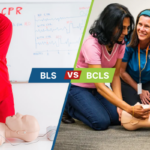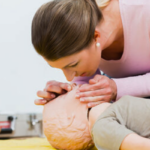- Last Updated On: January 29, 2024
What is Cardiac Massage and Types of Cardiac Massage Techniques
Did you know that before the 1960’s an open heart massage was a common procedure? However with the advent of CPR, things changed. Now an external cardiac massage is a fundamental component of cardiopulmonary resuscitation (CPR). It is a life-saving technique employed during cardiac arrest. Most people mistake CPR for cardiac massage. However, they are not entirely the same. Here, you can empower yourself with the knowledge of cardiac massage and how it differs from CPR. Read on for more information on this topic.
What is a Cardiac massage?
Cardiac massage, or chest compressions, is a life-saving technique performed during cardiac arrest or when the heart stops beating. The goal is to manually compress the chest to help circulate blood throughout the body and save the vital organs until more advanced medical intervention, such as defibrillation, can be administered. It involves rhythmic chest compressions at a specific rate and depth to maintain blood flow and increase the chances of restoring a heartbeat. CPR is a critical skill for common people and healthcare professionals alike.
Cardiac Massage Vs CPR
Cardiac massage and CPR (cardiopulmonary resuscitation) are terms often used interchangeably, but they refer to components of the same life-saving process. Here is a clarification between the two:
Cardiopulmonary Resuscitation (CPR): CPR is a broader term encompassing various life-saving emergency techniques. It typically includes chest compressions (cardiac massage), rescue breaths (mouth-to-mouth respiration), and, in some cases, an AED. CPR maintains blood circulation and oxygenation to vital organs until professional medical help arrives.
Cardiac Massage: Cardiac massage refers explicitly to the chest compression component of CPR. During cardiac massage, rhythmic compressions are applied to the chest to manually pump blood through the circulatory system. The focus is maintaining blood flow to prevent damage to vital organs, especially the brain. Some professionals also call it the heart massage, for better understanding.
When Should You Use Cardiac Massage Techniques?
Some key indications for performing cardiac massage techniques encompass the following situations:
- Sudden Collapse: If an individual suddenly collapses and is not responding, immediate cardiac massage is the only way forward.
- Absence of a Pulse: Start cardiac massage when you cannot detect a pulse in a responsive person. Surgeons may need to deliver an open heart massage during surgeries, if needed.
Who Should Perform a Cardiac Massage?
Anyone trained in CPR should perform sternum massage. Bystanders witnessing a person in cardiac arrest should promptly initiate chest compressions. Healthcare professionals, first responders, and individuals with CPR training are well-equipped to administer this life-saving technique. Quick action is vital to maintaining blood circulation and increasing the chances of successful resuscitation. While professional medical assistance is crucial, bystanders’ immediate initiation of cardiac massage significantly improves the overall outcomes during cardiac emergencies. Only experienced surgeons should go for an internal cardiac massage. It requires expertise and precision from the healthcare professional.
Cardiac Massage Techniques: Types of Heart Massage
Cardiac massage, also known as chest compressions or cardiopulmonary resuscitation (CPR), has two techniques:
- Hands-Only CPR: This technique involves using only chest compressions without rescue breaths. Bystanders who are untrained or uncomfortable giving rescue breaths should use this technique. The focus is on providing uninterrupted chest compressions at a specific rate and depth.
- Conventional CPR: Conventional CPR combines chest compressions with rescue breaths. After chest compressions, the rescuer provides rescue breaths to supply oxygen to the person’s lungs. Trained individuals, including healthcare professionals, typically use this method.
How Does Cardiac Massage Save Lives?
Cardiac massage, or chest compressions, saves lives during cardiac arrest. Here’s how it works:
- Maintains Blood Circulation: A cardiac arrest stops the flow of blood in the body. Cardiac massage involves rhythmic chest compressions that manually pump the blood, helping to maintain circulation throughout the body.
- Supplies oxygen to vital organs: The compressions create pressure changes in the chest, facilitating blood movement and oxygen delivery to the brain.
- Buys Time for Professional Help: Cardiac massage is a critical intervention that saves valuable time until professional medical help arrives. It sustains minimal blood flow, preventing irreversible damage to organs while awaiting more advanced treatments like defibrillation.
- Increased Chance of Successful Resuscitation: Immediate initiation of cardiac massage significantly increases the chances of successfully resuscitating someone experiencing cardiac arrest. It can be a crucial link in the chain of survival, especially when combined with other interventions like defibrillation.
- Accessible and learnable by bystanders: Cardiac massage is a technique that bystanders can quickly initiate, even if they lack expertise in the medical field. Early intervention by bystanders before the arrival of professional help is vital for positive outcomes.
Read More: https://cprcare.com/how-to-stay-calm-and-focused-while-handling-cpr-emergency/
Conclusion
The process of stimulating the heart to restart after a cardiac arrest is known as a cardiac massage. You can administer an external cardiac massage via chest compressions to someone in cardiac arrest. This technique is crucial in saving lives as it helps to regain nerve conduction to the heart muscles and pumps oxygenated blood through the system. It keeps the vital organs alive until emergency medical help arrives.






